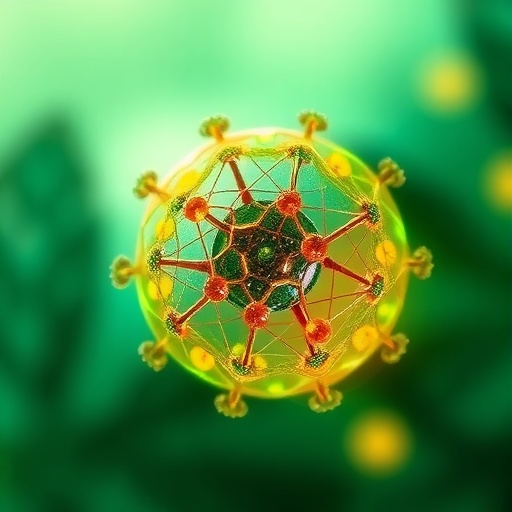In recent advancements in nanomaterials, researchers Krishnaiah and Kumar have unveiled a groundbreaking method for synthesizing a novel nanocomposite comprising zinc oxide (ZnO) and nickel oxide (NiO) using an environmentally friendly approach. This research not only demonstrates the utility of neem leaf extracts in nanotechnology but also amplifies its significance in electrochemical sensing and photocatalytic applications. The importance of eco-friendly synthesis techniques in materials science cannot be stressed enough, especially in a world increasingly devoted to sustainability and ethical chemical practices.
The synthesis of the ZnO-NiO nanocomposite highlights a significant stride towards creating materials that are not only effective but are also produced through green processes. Traditionally, the fabrication of such nanocomposites often involves toxic precursors and complex processes. However, synthesizing ZnO and NiO through neem leaf extract marks a paradigm shift, promoting the use of natural resources that are abundant and biodegradable. Neem leaves have long been known for their medicinal properties, but their role in nanotechnology opens up new avenues for research and applications.
Utilizing the extracts from neem leaves as a reducing and stabilizing agent in the synthesis of ZnO-NiO nanocomposites allows for not only an efficient production method but also enhances the biocompatibility of the nanomaterials. This is particularly essential in applications that may come into contact with biological systems. The researchers emphasized how the reduction process leads to finely tuned nanoscale structures that maximize surface area and enhance reactivity—critical parameters for electrochemical sensors and photocatalysts.
Moreover, the unique physical and chemical properties of the resulting ZnO-NiO nanocomposite make it an intriguing candidate for a host of applications ranging from environmental remediation to energy conversion. The hybrid nature of the composite combines the excellent photocatalytic properties of ZnO with the electrical conductivity and corrosive stability of NiO, forming a synergy that could significantly improve the performance of devices designed for pollutant degradation under UV illumination or electrochemical reactions.
Characterizing the synthesized nanocomposite was a pivotal aspect of the research. Advanced techniques such as X-ray diffraction, scanning electron microscopy, and Fourier-transform infrared spectroscopy were employed to investigate the material’s morphology, crystalline structure, and functional groups. The researchers reported a successful integration of ZnO and NiO, confirming the formation of a composite material that exhibits properties distinct from its individual components. The structural robustness and optimal particle size are expected to present significant advantages in practical applications.
The electrochemical sensor applications of this ZnO-NiO nanocomposite were tested using various electrochemical techniques. The performance metrics indicated a remarkable sensitivity to target analytes, with a rapid response time and a broad linear detection range. Such attributes mark a significant improvement over existing sensor technologies, offering the potential for enhanced detection of toxins or pollutants in real-time, which is crucial for environmental monitoring and safety.
In addition to its electrochemical applications, the photocatalytic efficacy of the ZnO-NiO nanocomposite also garnered attention. Under UV light irradiation, preliminary tests showed a pronounced efficiency in degrading common organic pollutants in aqueous solutions. The underlying mechanisms contributing to this efficiency revolve around the generation of reactive oxygen species that facilitate the breakdown of complex molecules into benign products, showcasing the potential for practical applications in wastewater treatment and air purification.
The implications of this research extend far beyond mere synthesis methods or academic curiosity; they speak to the heart of modern technological challenges. As the world grapples with pressing environmental issues, including pollution and waste management, the need for innovative and sustainable solutions is more critical than ever. The development of materials such as the ZnO-NiO nanocomposite could represent a key component in the toolbox of future environmental technologies.
Furthermore, the researchers argue that beyond direct applications, their green synthesis method sets a precedent for future studies on similar nanocomposites. The framework established by utilizing neem leaf extract serves as an encouraging model for other researchers to explore the potential of plant-derived compounds in nanomaterial synthesis. This not only fosters innovation but also promotes eco-conscious research practices within the scientific community.
In conclusion, the study presented by Krishnaiah and Kumar marks an important contribution to the field of nanotechnology, offering a green synthesis pathway that harnesses the power of nature for cutting-edge applications. The synthesis of the ZnO-NiO nanocomposite demonstrates that effective technologies can be developed without compromising the environment, thus reflecting the growing intersection between sustainability and scientific advancement. Researchers, environmentalists, and industrialists alike will keenly observe the developments stemming from this study as they pave the way for a cleaner, greener future in nanotechnology.
As we stand on the brink of a new era in materials science, the impact of this research may echo throughout various industries, inspiring further innovations and encouraging sustained investment in eco-friendly materials. The collaboration of natural resources with sophisticated technology exemplifies a holistic approach to innovation—a model that might become essential as humanity seeks to rectify the environmental challenges that lie ahead.
While challenges remain around the scaling of green synthesis processes to industrial levels, the promise illustrated by ZnO-NiO nanocomposites inspires optimism. Moving forward, the quest for efficiency, efficacy, and environmental responsibility in technology could very well define the next chapter of scientific progress.
Research like that conducted by Krishnaiah and Kumar not only enhances our understanding of nanocomposites but also encourages a broader conversation about the role of sustainability in the future of science and technology. Embracing eco-friendly principles is not just a trend; it is becoming the standard in pursuit of a sustainable and technologically advanced future.
Subject of Research: Green synthesis of ZnO-NiO nanocomposite via neem leaf extract for electrochemical sensing and photocatalytic applications.
Article Title: Green synthesis of ZnO-NiO nanocomposite via neem leaf extract for electrochemical sensing and photocatalytic applications.
Article References: Krishnaiah, C.V., Kumar, B.D. Green synthesis of ZnO-NiO nanocomposite via neem leaf extract for electrochemical sensing and photocatalytic applications. Ionics (2025). https://doi.org/10.1007/s11581-025-06647-w
Image Credits: AI Generated
DOI: https://doi.org/10.1007/s11581-025-06647-w
Keywords: nanocomposite, ZnO, NiO, green synthesis, neem leaf extract, electrochemical sensing, photocatalytic applications, environmental remediation, sustainability, nanotechnology.




